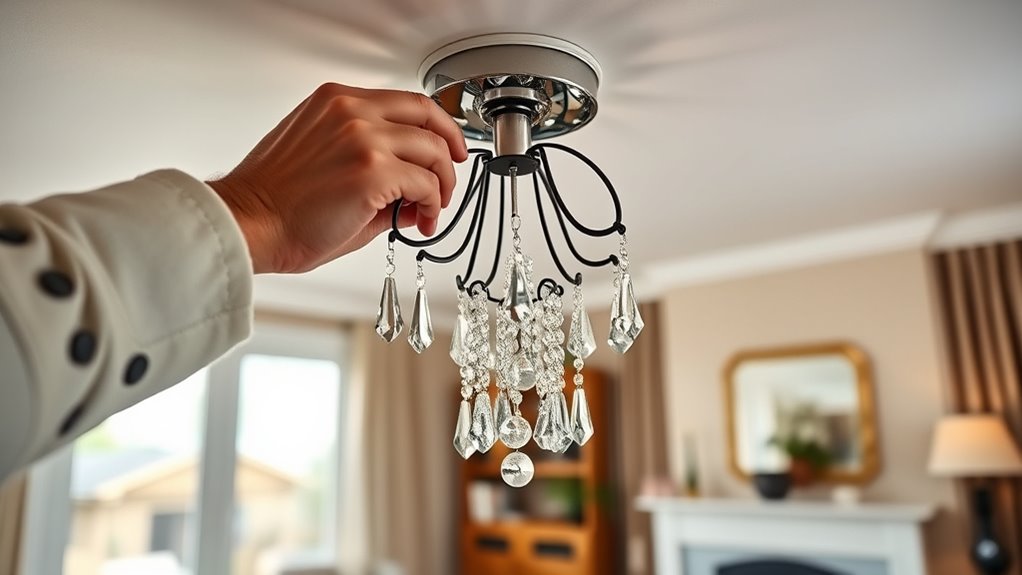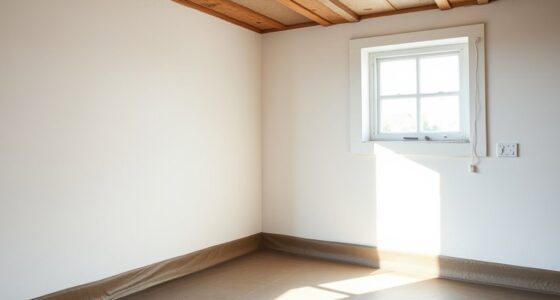Replacing a light fixture can be a safe DIY project if you take proper precautions. Turn off the power at the circuit breaker before starting, and carefully follow the manufacturer’s instructions. Check that the fixture is securely mounted and compatible with your electrical box. Use the right bulbs and wiring connections, and always verify the fixture is stable before restoring power. If you stay careful, you can do it confidently—there’s more to ensure a safe and professional-looking result as you continue.
Key Takeaways
- Turn off power at the circuit breaker before starting any work to prevent electrical shock.
- Use compatible bulbs and verify wattage limits to ensure safety and proper fixture operation.
- Securely attach the fixture to a proper mounting bracket, ensuring it supports the weight and hangs straight.
- Connect wiring correctly: black to black, white to white, and ground to ground; follow manufacturer instructions.
- Consult a licensed electrician for guidance, code compliance, and to ensure safe, professional installation.

Replacing light fixtures is a straightforward way to update your home’s appearance and improve lighting. When tackling this project, one of the first things you’ll need to focus on is fixture mounting. Making sure the new fixture is securely attached to the ceiling or wall is essential for safety and stability. Take the time to examine the existing mounting bracket; if it’s damaged or incompatible with the new fixture, replace it. Many fixtures come with mounting hardware designed for standard electrical boxes, but some may require adapters or additional mounting plates. Make certain the fixture’s mounting method matches your space and that it can support the weight of the new fixture without strain. Proper fixture mounting not only guarantees safety but also ensures the fixture hangs straight and looks professional. Additionally, consulting a licensed electrician can help ensure your installation complies with local electrical codes and safety standards.
Another important aspect to consider is bulb compatibility. Different fixtures are designed for specific bulb types, sizes, and wattages. Before purchasing a new fixture, check the manufacturer’s specifications to determine the compatible bulb types—whether incandescent, LED, CFL, or others. This step prevents installing a fixture that can’t accommodate your preferred bulbs or, worse, causes electrical issues. Once installed, using bulbs that match the fixture’s recommended wattage is essential to avoid overheating and potential fire hazards. Additionally, consider the bulb base type; some fixtures require specific bases like E26 or GU10. Confirming bulb compatibility before installation makes the process smoother and helps you enjoy the new lighting without surprises.
When you’re ready to replace your fixture, start by turning off the power at the circuit breaker to eliminate any risk of shock. Remove the old fixture carefully, noting how it’s connected, and take pictures if needed for reference. Next, attach the new mounting bracket if required, ensuring it’s firmly secured to the electrical box. Connect the wiring—typically black to black (hot), white to white (neutral), and green or bare copper to the ground wire—using wire nuts. Once the wiring is secure, attach the fixture to the mounting bracket following the manufacturer’s instructions. Hang the fixture straight and tighten all screws, then install the bulbs, making sure they’re compatible with your fixture. Finally, restore power and test the new light to confirm everything works properly.
Frequently Asked Questions
Can I Replace a Light Fixture Without Turning off the Power?
You shouldn’t replace a light fixture without turning off the power. Electrical safety is essential, and working with live wires can lead to electrocution or damage. Always shut off the circuit breaker before starting any DIY tips for electrical work. This guarantees your safety and helps prevent accidents. Remember, even if it seems convenient, working with power on is risky and not worth the potential harm.
What Tools Are Essential for Replacing Light Fixtures Safely?
Think of replacing a light fixture like first tending a garden—tools are your essential seeds. You’ll need a screwdriver, pliers, voltage tester, and wire strippers. Always prioritize basic safety by double-checking power is off with your tester, and keep your tools in good condition through proper maintenance. These steps make sure you work efficiently, avoid accidents, and create a safe, bright space you can enjoy with confidence.
How Do I Identify the Correct Wattage for a New Fixture?
You identify the correct wattage for a new fixture by checking its fixture specifications, which include the maximum wattage recommended. Verify wattage compatibility with your existing wiring and fixture to prevent overheating. Always compare the fixture’s specified wattage limit with your bulb choice. If unsure, consult the manufacturer’s instructions or an electrician. Keeping the wattage within specs helps maintain safety and fixture longevity.
What Should I Do if the Existing Wiring Is Damaged?
Think of your wiring as the veins of your home—if they’re damaged, blood flow (electricity) can be compromised. First, turn off the power and conduct a wiring inspection to spot damage. If you find frayed or broken wires, do a damage assessment and replace or repair them before installing your new fixture. Never ignore damaged wiring; it’s risky and could cause electrical fires or shock.
Is It Necessary to Hire an Electrician for Simple Replacements?
For simple replacements, you don’t always need an electrician, but you should prioritize DIY safety and comply with electrical codes. If you’re comfortable with basic electrical work, turn off power at the breaker, use insulated tools, and double-check wiring connections. However, if you’re uncertain or unfamiliar with electrical codes, it’s safer to hire a professional to avoid hazards and ensure your project meets all safety standards.
Conclusion
So, after all that effort, you’ve become a DIY electrician—saving money and feeling proud. Just remember, replacing a light fixture might seem simple, but one wrong move could turn your bright idea into a shocking experience. Irony’s a funny thing; sometimes the safest fix is knowing when to call in the pros. Still, with care and respect for electricity, you’ve lit up your space—and maybe, just maybe, learned a thing or two about staying safe.









